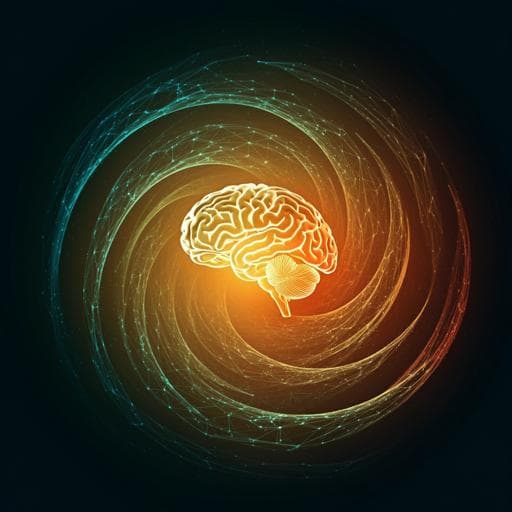
Psychology
Personalized functional brain network topography is associated with individual differences in youth cognition
A. S. Keller, A. R. Pines, et al.
Discover how individual differences in cognition during childhood correlate with functional brain network topography in this groundbreaking study by Arielle S. Keller and colleagues. By analyzing data from the Adolescent Brain Cognitive Development Study, the research reveals that personalized functional networks are linked to cognitive abilities in children aged 9-10. This work provides crucial insights into how brain development influences future health and social outcomes.
~3 min • Beginner • English
Introduction
The study investigates how individual differences in functional brain network topography relate to cognitive performance in youth. Prior fMRI studies often used group-standard atlases that assume one-to-one functional–structural correspondence across individuals, an assumption shown to be false due to substantial inter-individual heterogeneity, especially in association cortex. Precision functional mapping enables person-specific network definitions (personalized functional networks, PFNs), which are stable and predictive of task activation. The authors hypothesize that PFN topography, particularly within association networks along the sensorimotor–association (S-A) hierarchical axis (e.g., fronto-parietal, ventral attention, default mode), is associated with and can predict individual differences in cognition in children. Addressing reproducibility concerns, they leverage very large, matched discovery and replication samples from the ABCD Study to test whether PFN topography predicts general cognition and specific domains (executive function, learning/memory), and whether prediction strength aligns with the S-A axis.
Literature Review
The paper reviews evidence that higher-order cognition engages large-scale association networks and that individual-specific functional topography varies markedly across individuals, especially in association cortex (Laumann 2015; Gordon 2017; Kong 2019). It highlights the S-A axis as a principal organizational gradient spanning unimodal to transmodal cortices and aligning with multiple cortical properties (myelination, evolution, metabolism, functional gradients). Networks near the association pole (fronto-parietal, ventral attention, default mode) show high variability and are implicated in adult psychiatric cognitive impairments. Previous work by the authors found larger cortical representation of fronto-parietal PFNs associated with better cognition and that PFN topography predicts cognition; however, prior data were single-site and not yet replicated. The reproducibility crisis in brain–behavior studies underscores the need for large samples, cross-validated predictive modeling, and accounting for individual-specific neuroanatomy to avoid weak effects and overfitting.
Methodology
Participants: Data from the ABCD baseline cohort (ABCC ABCD-3165) included 11,878 children aged 9–10 years across 21 sites; after exclusions for incomplete data and excessive motion, n = 6,972 remained. Two socio-demographically matched samples were created for discovery (n = 3,525) and replication (n = 3,447), balanced on age, sex, site, ethnicity, parent education, income, etc.
Cognitive assessment: Nine tasks (7 NIH Toolbox: Picture Vocabulary, Flanker, List Sort Working Memory, Dimensional Change Card Sort, Pattern Comparison Processing Speed, Picture Sequence Memory, Oral Reading; plus Little Man Task, Rey Auditory Verbal Learning Task). Previously derived Bayesian probabilistic PCA (BPPCA) factors were used: (1) general cognition, (2) executive function, (3) learning/memory.
Imaging and preprocessing: Data processed via ABCD-BIDS/DCAN BOLD Processing pipelines: distortion correction, alignment, ANTs-based denoising, FreeSurfer segmentation, surface and volume registration (FSL FLIRT), de-meaning/detrending, GLM denoising (signal and motion regressors), bandpass 0.008–0.09 Hz (2nd-order Butterworth), respiratory motion filter, motion censoring (FD>0.2 mm or ±3 SD outliers). Resting-state and three task fMRI runs (MID, SST, EN-back) were concatenated to maximize data; participants with <600 post-scrubbing TRs or failed QC were excluded. ComBat harmonization was applied for linear mixed-effects analyses (protecting age, sex, family), while site was included as a covariate in predictive models to avoid leakage.
Personalized Functional Networks (PFNs): Spatially-regularized non-negative matrix factorization (NMF) was applied per participant to derive 17 PFNs using a previously derived group consensus atlas as initialization. Regularization included a group consensus term (preserving correspondence) and data locality term (spatial smoothness/coherence); parameters matched prior validations with increased locality regularization to account for vertex size differences. Inputs were re-scaled to nonnegative ranges. Outputs included soft parcellations (vertex-wise network weights) and hard parcellations (max-weight label per vertex). Split-half reliability in high-duration resting-state subsets showed high ICCs (0.84–0.99) across networks.
Measures of PFN topography: Total cortical representation per PFN computed as the sum of vertex loadings (soft parcellation), reflecting spatial extent. S-A axis rank per PFN computed by averaging archetypal S-A rank across its vertices (hard parcellation).
Statistical analyses:
- Linear mixed-effects models (R lme4) tested associations between total cortical representation and cognition (primarily general cognition), with fixed effects of age, sex (assigned at birth), mean FD; random intercept for family; ComBat-harmonized data across sites; Bonferroni correction for multiple comparisons.
- Predictive modeling: Ridge regression trained on multivariate PFN topography (vertex-wise loadings across 17 PFNs), covarying age, sex, site, and mean FD. Primary evaluation used matched discovery/replication nested two-fold cross-validation (outer 2F-CV for generalizability; inner 2F-CV for hyperparameter selection across 16 alphas, optimizing normalized sum of correlation r and reciprocal MAE). Repeated random 2F-CV with 100 iterations assessed stability. Permutation testing (outcome shuffling) generated null distributions. Independent models trained per PFN assessed network-specific contributions. Sensitivity analyses included deriving cognition factors separately within discovery/replication, predicting individual task scores, and resting-only PFN derivations.
- Alignment with cortical hierarchy: Spearman correlations between per-PFN prediction accuracy and PFN S-A rank were tested for each cognitive domain; significance assessed with spin-based spatial permutation tests (1,000 rotations) preserving spatial covariance.
Key Findings
- PFN topography predicts general cognition out-of-sample:
- Discovery→Replication: r(3525) = 0.41, p < 0.001 (95% CI [0.39, 0.44]).
- Replication→Discovery: r(3447) = 0.45, p < 0.001 (95% CI [0.43, 0.48]).
- Repeated random 2F-CV (100 runs): mean r = 0.44, p < 0.001 (95% CI [0.43, 0.44]); significantly above permutation null.
- PFN-specific models: highest accuracies for ventral attention and fronto-parietal networks; lowest for somatomotor and visual.
- PFN topography predicts executive function and learning/memory with lower accuracy than general cognition:
- Executive function: Discovery r(3525) = 0.17, p < 0.001 (95% CI [0.14, 0.20]); Replication r(3447) = 0.16, p < 0.001 (95% CI [0.13, 0.20]); repeated random 2F-CV mean r = 0.17, p < 0.001.
- Learning/memory: Discovery r(3525) = 0.27, p < 0.001 (95% CI [0.24, 0.30]); Replication r(3447) = 0.27, p < 0.001 (95% CI [0.24, 0.30]); repeated random 2F-CV mean r = 0.28, p < 0.001.
- For both domains, ventral attention and fronto-parietal PFNs contributed most; all PFN-specific accuracies significant after Bonferroni correction.
- Alignment with cortical hierarchy (S-A axis): Prediction accuracy across PFNs increased with higher S-A rank for all domains, with significant Spearman correlations and spin-test p-values:
- General cognition: Spearman r = 0.601, P_spin = 0.012.
- Executive function: Spearman r = 0.547, P_spin = 0.025.
- Learning/memory: Spearman r = 0.537, P_spin = 0.028.
- Univariate associations (total cortical representation): Linear mixed-effects models showed positive associations between general cognition and total cortical representation of fronto-parietal PFNs (networks 3, 15, 17) in both discovery and replication; effects remained after controlling for psychotropic medication and socioeconomic status (Bonferroni-corrected). One somatomotor PFN (network 4) showed inverse associations in both samples; another somatomotor PFN (network 2) inversely associated in discovery only. Head motion (mean FD) was positively related to total cortical representation in several models, consistent with known motion effects.
- PFN-based models outperformed models using socio-economic status (areal deprivation index) alone in predicting cognition (Supplementary Table 1).
Discussion
Findings robustly support the hypothesis that individual-specific functional topography, especially within association networks, relates to cognitive performance in children and can predict cognition in unseen participants. The strongest predictive contributions from fronto-parietal and ventral attention networks, and the systematic increase in prediction accuracy along the S-A axis, indicate that domain-general cognitive abilities are supported by larger and more variable association cortices. The replication in two large, matched samples addresses reproducibility concerns in brain–behavior research, demonstrating generalizability beyond single-site studies and group-average atlases. Precision functional mapping capitalizes on inter-individual variability rather than averaging it out, yielding comparatively larger and more reliable effects. The results align with developmental theories positing that the S-A axis becomes more prominent through adolescence and that association cortices, which show evolutionary expansion and prolonged plasticity, underlie higher-order cognition. These insights suggest that PFN topography could serve as a sensitive biomarker for individual differences in youth cognition and potentially inform early identification of risk for later cognitive impairments and psychiatric outcomes.
Conclusion
This study provides large-scale, reproducible evidence that personalized functional brain network topography is meaningfully associated with and predictive of individual differences in cognition in youth. Multivariate PFN topography predicts general cognition most strongly, with weaker but significant predictions for executive function and learning/memory. Predictive strength scales with a network’s position along the sensorimotor–association axis, highlighting association cortices as key substrates of domain-general abilities. Univariate analyses further show that greater cortical representation of fronto-parietal PFNs is positively related to general cognition, whereas some somatomotor networks show inverse relationships. Future work should leverage longitudinal ABCD data to examine how developmental changes in PFN topography predict cognitive trajectories, incorporate subcortical precision mapping, assess additional cognitive domains (e.g., social cognition), and evaluate environmental and socio-demographic influences on PFN development. Such studies may guide targeted interventions to support healthy neurocognitive development.
Limitations
- Cross-sectional baseline analysis precludes inference about within-person cognitive change or longitudinal prediction.
- Head motion remains a challenge in pediatric fMRI; although mitigated via preprocessing, censoring, covariates, and harmonization, associations between motion and PFN measures were observed.
- PFNs were derived from concatenated resting and task fMRI to maximize data; although intrinsic networks are similar across states, task inclusion could introduce state-related influences (results replicated in resting-only subset).
- Differences from the original study (scanning sequences, templates, cognitive measures) prevented direct model transfer; this study is a conceptual replication using new data and methods.
- Registration to common reference space can introduce region-specific warping; effects on behavior–topography associations warrant future investigation.
- Analyses were limited to cortical surface; subcortical precision mapping was not included.
- Potential confounding from socio-demographic/environmental factors remains; sensitivity analyses addressed SES, but broader exposome influences should be explored.
Related Publications
Explore these studies to deepen your understanding of the subject.







